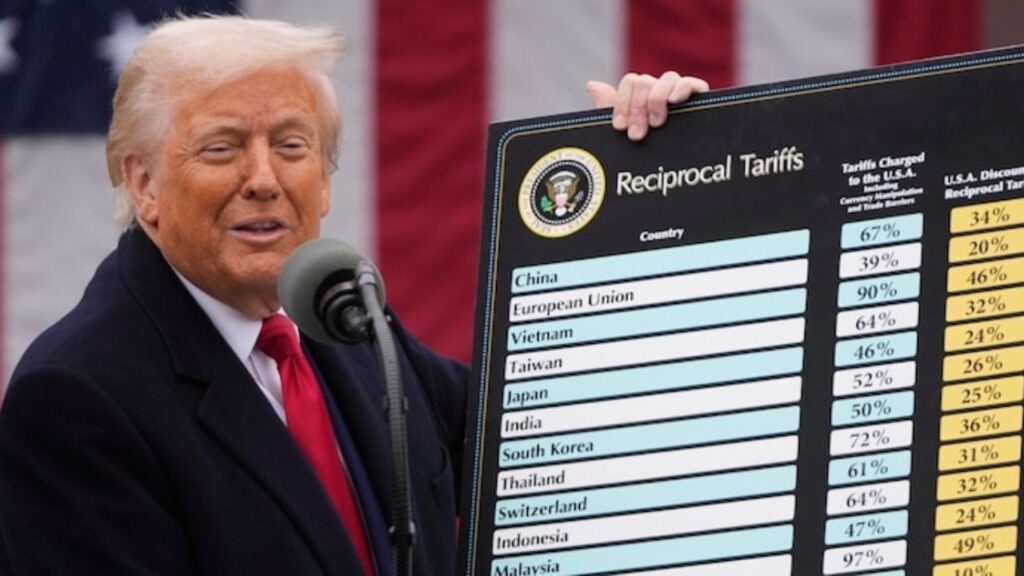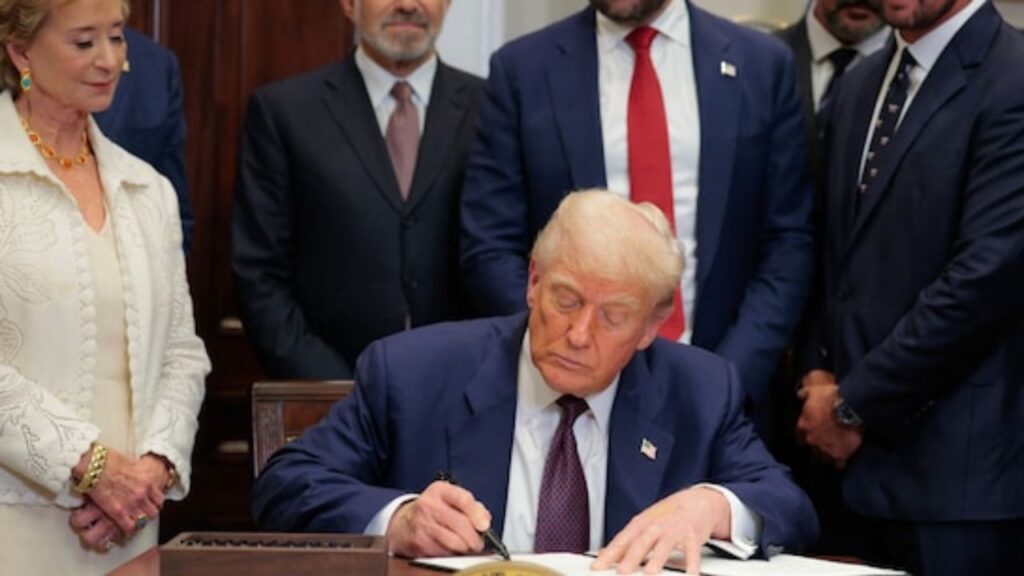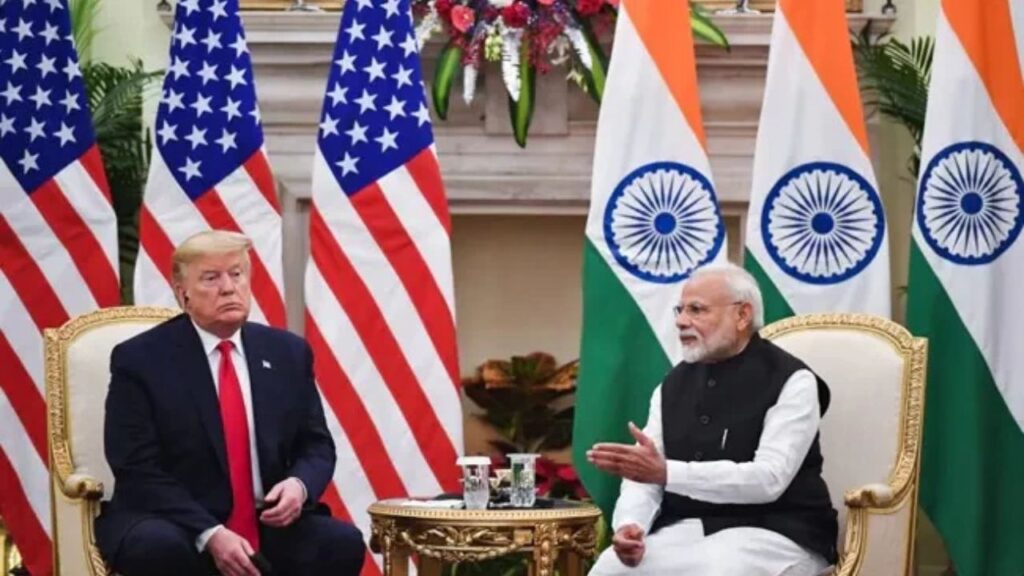Trump India Tariff: Donald Trump’s aggressive tariff policy, including a 25% tariff on Indian goods effective August 1, 2025, and an unspecified “penalty” for India’s defense and energy imports from Russia, has disrupted New Delhi’s trade assumptions. Indian policymakers had anticipated a bilateral trade deal involving mutual concessions, a 10-20% tariff differential favoring India over China, and U.S. respect for India’s longstanding priorities—such as opposition to GM food crops and protection of its labor-intensive, subsistence-level manufacturing sector, which drives significant export activity.
The Indian Commerce and Industry Ministry publicly acknowledged Trump’s announcement, stating it is “studying its implications” while reaffirming its commitment to a “fair, balanced, and mutually beneficial” trade agreement that prioritizes the welfare of India’s farmers, entrepreneurs, and MSMEs. Privately, a senior official noted that the 25% tariff aligns closely with Trump’s earlier “reciprocal tariff” proposal of 26%, but expressed concern over the lack of clarity surrounding the additional penalties and their cumulative impact alongside other sectoral tariffs. The official emphasized that India will not negotiate under pressure.

The government remains wary of rushed trade deals, citing examples like the UK and Australia, which secured agreements with the U.S. but ended up with unfavorable terms and persistent trade deficits. “We’d rather wait for an equitable deal that safeguards our farmers and small enterprises. No deal is better than a bad one,” the official told The Indian Express.
India is also uneasy about Trump’s recent U.S.-Pakistan deal to access Pakistan’s “massive oil reserves,” following a prior crypto agreement with Islamabad. The official remarked, “Countries can decide their trade-offs, but India has limits on how far it will go for concessions. Others may not.” New Delhi remains focused on securing a fair agreement, even if it means enduring short-term export disruptions from Trump’s tariffs. “Temporary pain is preferable to long-term harm,” the official concluded.
US-India Trade Deal: Strategic Considerations and Challenges Trump India Tariff
India is navigating complex trade negotiations with the United States, with indications that the timeline for a potential deal, initially set for October, could be accelerated if talks progress favorably. The urgency stems from the need to maintain a competitive tariff gap with China, which is at an advanced stage of securing a trade agreement with the US. China’s deal may include favorable tariff rates and exemptions from secondary tariffs, such as those tied to Russian oil imports or the proposed 10% BRICS tariff. Currently, China faces a 30% US tariff.
For India, securing a deal—potentially an early-harvest agreement—is critical to preserving its tariff advantage over China. India’s past decision to withdraw from the Regional Comprehensive Economic Partnership (RCEP) due to agricultural sector concerns highlights its cautious approach. However, there is now greater openness in New Delhi to reduce tariffs on select industrial goods and offer concessions in public procurement and agriculture, provided the US reciprocates, as seen in India’s recent trade deal with the UK.

To address the US trade deficit concerns frequently raised by the Trump administration, India has signaled readiness to increase imports in key sectors: defense equipment, fossil fuels, and nuclear technology. This aligns with India’s broader strategy to balance trade relations while safeguarding economic interests.
Indian policymakers recognize the US’s historical role in fostering open trade, which drove global economic growth, including for India. Prior to January 2025, the effective US tariff on Indian goods was just 4%, with minimal non-tariff barriers—a result of bipartisan US policy. However, some Indian officials express concern over the current administration’s push for reciprocal concessions, viewing it as a departure from this open stance. Economists warn that a higher-than-expected US tariff, particularly if it disproportionately affects India compared to China, could hinder India’s growth trajectory.
A significant complication arises from potential US penalties on India’s imports of Russian oil and defense equipment. While former President Trump did not specify the penalty rate, past statements suggest it could reach 100%. Such a tariff would erode India’s competitive edge over China, even if China faces similar penalties for Russian imports, until a deal is finalized.
India’s strategy hinges on accelerating negotiations to secure a balanced agreement that mitigates tariff risks, aligns with domestic priorities, and maintains its position in global trade dynamics.
The Global Trade Research Initiative (GTRI) stated on Wednesday that India’s tariffs align with World Trade Organization (WTO) rules, countering former President Trump’s claims about India’s non-tariff barriers. By holding firm on key issues like agriculture, India has avoided a potentially unbalanced trade deal. GTRI noted that India’s non-tariff barriers are standard globally, and its purchase of discounted Russian oil has helped curb inflation amid international market fluctuations. Over 90 countries face similar U.S. trade pressures, and any future agreement must be equitable. India’s resolute position is seen as a strategic success for now.
On Monday, Trump issued a warning, giving Moscow a 10-12 day deadline to advance toward a Ukraine peace deal or face secondary tariffs of 100% on countries purchasing Russian oil. U.S. Treasury Secretary Scott Bessent emphasized readiness for these sanctions, impacting major buyers like China (2 million barrels per day), India (slightly under 2 million), and Turkey.
Recent U.S.-India trade talks suggest an interim agreement remains elusive, with a potential deal unlikely before September and October as a possible deadline. A sixth round of negotiations is expected in August. Without additional levies like the BRICS tariff or Russian oil penalty, India’s 25% tariff rate compares favorably to Indonesia (19%) and Vietnam (20-40%), which have finalized deals. However, China (30-34%) and Bangladesh (35%) face higher tariffs. The Russian oil penalty’s application remains unclear, complicating calculations.
If an interim deal results in a U.S. tariff on India between 10% and 15%—levels offered to the UK and Japan—India could view it as a win. Benefits diminish if tariffs exceed 15%, nearing Vietnam’s 20%. A trans-shipment clause, like Vietnam’s additional 20% tariff on goods with foreign inputs, could challenge India, given its reliance on imported components from countries like China in sectors such as pharmaceuticals, engineering, and electronics.
Uncertainty Surrounding US Trade Deals and Their Global Impact

The reliability of trade agreements under the current US administration is increasingly questionable. Proposals such as a new BRICS tariff, additional duties on copper and pharmaceuticals, high tariffs on allies like Japan and South Korea, or President Trump’s potential reversal on the USMCA deal—originally signed during his previous term—highlight the unpredictability of US trade policy. This uncertainty undermines the sanctity of US trade agreements, posing risks to global economic stability and cooperation. Businesses worldwide face challenges in planning due to these frequent policy shifts, with global supply chain experts noting the high costs and complexity of relocating manufacturing operations.
India is closely monitoring the US’s final tariff decisions on China, anticipating that the administration will maintain a tariff differential. Recent US-China trade talks in Stockholm concluded without significant progress, though China’s lead negotiator, Li Chenggang, announced an agreement to extend a 90-day tariff truce from mid-May, with details on timing and duration unspecified. Indian officials are tracking the effective duty on Chinese goods in US ports, particularly in commodity sectors where Indian producers are competitive, to assess the tariff differential with India. A 10-20% differential is expected to offset India’s structural challenges, including infrastructure bottlenecks, logistics issues, high interest rates, and business costs.
Additional tariffs on steel, aluminum, and a new 50% duty on copper products effective August 1 further complicate matters for India, which exported $2 billion in copper products globally in 2024-25, with 17% directed to the US. President Trump’s push for zero-duty access to India’s market, similar to US agreements with Vietnam and Indonesia, adds another layer of difficulty for Indian negotiators.
With official-level talks expected to conclude by mid-August, a final trade deal may hinge on direct discussions between Prime Minister Narendra Modi and President Trump, given Trump’s central role in trade negotiations. Experts suggest that India’s best strategy is to secure a preliminary agreement now, laying the groundwork for further negotiations into 2026. However, with new tariffs and penalties targeting India, this critical conversation may occur sooner than anticipated.

